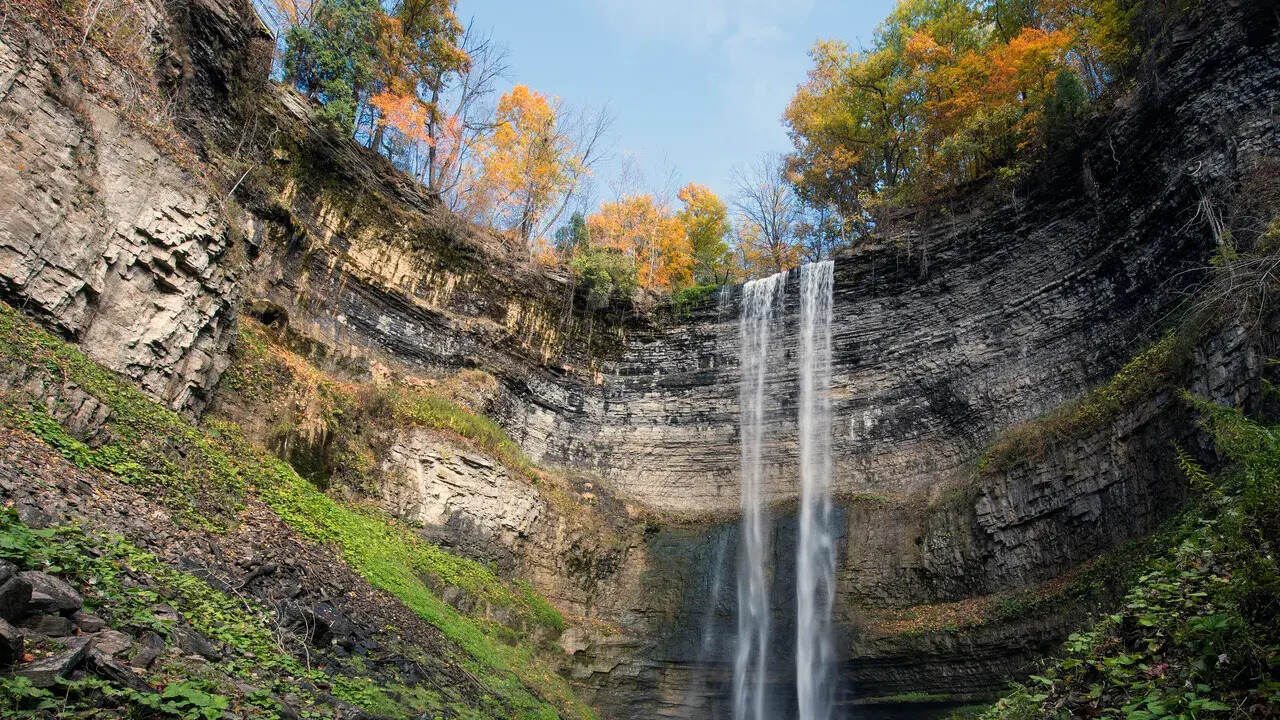
Did you know Canada is home to some of the most breathtaking waterfalls in the world? From the iconic Niagara Falls to hidden gems nestled in lush forests, Canada boasts a stunning array of cascading wonders. These natural beauties not only offer mesmerizing views but also provide habitats for diverse wildlife. Whether you're an avid hiker, a photography enthusiast, or simply someone who loves nature, exploring Canada's waterfalls can be a thrilling adventure. In this post, we'll dive into 28 fascinating facts about these majestic falls, shedding light on their history, geography, and unique features. Get ready to be amazed by the splendor of Canada's waterfalls!
Key Takeaways:
- Canada's waterfalls are truly majestic, with Niagara Falls being the most famous. It's a popular honeymoon spot and consists of three stunning waterfalls. Montmorency Falls is even taller than Niagara Falls and freezes in the winter, creating a beautiful sight.
- Helmcken Falls, Takakkaw Falls, Athabasca Falls, Della Falls, and Virginia Falls are also must-see wonders. Each has its own unique features, from massive ice cones to powerful flows. These natural beauties are waiting to be explored!
Majestic Waterfalls of Canada
Canada is home to some of the most breathtaking waterfalls in the world. These natural wonders draw visitors from all corners of the globe. Let's dive into some fascinating facts about these stunning cascades.
Niagara Falls
Niagara Falls is perhaps the most famous waterfall in Canada. It straddles the border between Ontario and New York.
- Niagara Falls consists of three waterfalls: Horseshoe Falls, American Falls, and Bridal Veil Falls.
- Horseshoe Falls is the largest of the three, with a height of 167 feet and a width of 2,700 feet.
- Over 168,000 cubic meters of water flow over Niagara Falls every minute during peak daytime hours.
- The falls were formed around 12,000 years ago during the last Ice Age.
- Niagara Falls is a popular honeymoon destination, earning it the nickname "Honeymoon Capital of the World."
Montmorency Falls
Located just outside Quebec City, Montmorency Falls is a stunning sight, especially in winter when it freezes.
- Montmorency Falls is 272 feet tall, making it nearly 100 feet taller than Niagara Falls.
- A suspension bridge allows visitors to walk directly over the falls for a thrilling view.
- In winter, the spray from the falls creates a large mound of ice known as the "Sugarloaf."
- The falls are named after Henri II, Duke of Montmorency, a viceroy of New France.
Helmcken Falls
Helmcken Falls is a hidden gem located in Wells Gray Provincial Park in British Columbia.
- Helmcken Falls is the fourth highest waterfall in Canada, with a drop of 463 feet.
- The falls were discovered in 1913 by Robert Lee, a land surveyor.
- In winter, the spray from the falls creates a massive ice cone at the base.
- Helmcken Falls is named after Dr. John Sebastian Helmcken, a physician and politician in British Columbia.
Takakkaw Falls
Takakkaw Falls, located in Yoho National Park, is one of the tallest waterfalls in Canada.
- Takakkaw Falls has a total height of 1,260 feet, with the main drop being 833 feet.
- The name "Takakkaw" comes from the Cree word for "magnificent."
- The falls are fed by the Daly Glacier, part of the Waputik Icefield.
- Takakkaw Falls is best visited in late spring or early summer when the snowmelt is at its peak.
Athabasca Falls
Athabasca Falls, located in Jasper National Park, is known for its powerful flow and stunning scenery.
- Athabasca Falls is not particularly high, standing at 75 feet, but it is incredibly powerful.
- The falls are carved through quartzite, creating a dramatic canyon.
- Athabasca Falls is easily accessible, with several viewing platforms and trails.
- The falls are fed by the Athabasca River, which originates from the Columbia Icefield.
Della Falls
Della Falls, located in Strathcona Provincial Park on Vancouver Island, is one of the tallest waterfalls in Canada.
- Della Falls has a total height of 1,444 feet.
- The falls are named after Della Green, the wife of prospector Joe Drinkwater, who discovered them.
- Reaching Della Falls requires a hike and a boat ride across Great Central Lake.
- The falls are fed by Della Lake, which sits at an elevation of 3,300 feet.
Virginia Falls
Virginia Falls, located in Nahanni National Park Reserve in the Northwest Territories, is a UNESCO World Heritage Site.
The Magic of Canadian Waterfalls
Canadian waterfalls offer more than just stunning views. They hold stories of nature's power and beauty. From the thunderous roar of Niagara Falls to the serene cascades of Shannon Falls, each waterfall has its own charm. These natural wonders are not just for tourists; they are a testament to the country's diverse landscape.
Visiting these waterfalls can be a refreshing escape from daily life. Whether you're an adventurer seeking a hike or someone looking for a peaceful spot to relax, Canadian waterfalls have something for everyone. They remind us of the simple joys found in nature and the importance of preserving these treasures for future generations.
So next time you plan a trip, consider exploring the breathtaking waterfalls of Canada. You'll leave with memories that last a lifetime and a deeper appreciation for the natural world.
Frequently Asked Questions
Was this page helpful?
Our commitment to delivering trustworthy and engaging content is at the heart of what we do. Each fact on our site is contributed by real users like you, bringing a wealth of diverse insights and information. To ensure the highest standards of accuracy and reliability, our dedicated editors meticulously review each submission. This process guarantees that the facts we share are not only fascinating but also credible. Trust in our commitment to quality and authenticity as you explore and learn with us.
